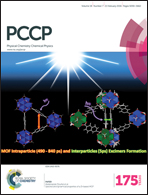Rational design of hierarchical ZnO superstructures for efficient charge transfer: mechanistic and photovoltaic studies of hollow, mesoporous, cage-like nanostructures with compacted 1D building blocks†
Abstract
Mesoporous and hollow zinc oxide (ZnO) hierarchical superstructures assembled with compact 1D building blocks that provide an efficient and faster transport pathway for photo-generated charge carriers have been synthesized using a biomass derived polysaccharide “alginic acid”. To understand the interactions between the organic bio-template and inorganic growth units of ZnO in aqueous medium, the effects of additives such as the alginate ion (ALGI) and ammonium hydroxide (NH4OH), along with the controlled reaction conditions, are investigated using Field Emission Scanning Electron Microscopy (FESEM) and powder X-ray diffraction. Dynamic and steady-state photoluminescence measurements are carried out to understand the charge transfer processes in the compact 1D superstructures. Experimental analyses reveal that the alginate ions, under hydrothermal reaction conditions, act as a structure directing agent and assemble 1D ZnO nanorods (NRs) hierarchically while NH4OH assists the formation of ZnO growth units. A plausible mechanism for ZnO cage formation is proposed based on the experimental observations. Morphology dependent photovoltaic properties of ZnO heterostructures, i.e., for ZnO cages, ZnO NRs and ZnO PNPs, have been studied along with electrochemical impedance spectroscopy (EIS). Enhancement of ∼60% and ∼35% in power conversion efficiency (PCE) is observed in ZnO cage based devices as compared to ZnO NR- and ZnO PNP-based devices, respectively.


 Please wait while we load your content...
Please wait while we load your content...